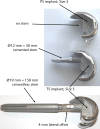The influence of stem length and fixation on initial femoral component stability in revision total knee replacement
- PMID: 23610659
- PMCID: PMC3626202
- DOI: 10.1302/2046-3758.111.2000107
The influence of stem length and fixation on initial femoral component stability in revision total knee replacement
Abstract
Objectives: Orthopaedic surgeons use stems in revision knee surgery to obtain stability when metaphyseal bone is missing. No consensus exists regarding stem size or method of fixation. This in vitro study investigated the influence of stem length and method of fixation on the pattern and level of relative motion at the bone-implant interface at a range of functional flexion angles.
Methods: A custom test rig using differential variable reluctance transducers (DVRTs) was developed to record all translational and rotational motions at the bone-implant interface. Composite femurs were used. These were secured to permit variation in flexion angle from 0° to 90°. Cyclic loads were applied through a tibial component based on three peaks corresponding to 0°, 10° and 20° flexion from a normal walking cycle. Three different femoral components were investigated in this study for cementless and cemented interface conditions.
Results: Relative motions were found to increase with flexion angle. Stemmed implants reduced relative motions in comparison to stemless implants for uncemented constructs. Relative motions for cemented implants were reduced to one-third of their equivalent uncemented constructs.
Conclusions: Stems are not necessary for cemented implants when the metaphyseal bone is intact. Short cemented femoral stems confer as much stability as long uncemented stems.
Keywords: Cemented; Femoral component micromotion; Influence of stems; Multiple flexion angles; Uncemented.
Conflict of interest statement
Figures






References
-
- Whittaker JP, Dharmarajan R, Toms AD. The management of bone loss in revision total knee replacement. J Bone Joint Surg [Br] 2008;90-B:981–987 - PubMed
-
- van Loon CJ, Kyriazopoulos A, Verdonschot N, et al. The role of femoral stem extension in total knee arthroplasty. Clin Orthop Relat Res 2000;378:282–289 - PubMed
-
- Beckmann J, Lüring C, Springorum R, et al. Fixation of revision TKA: a review of the literature. Knee Surg Sports Traumatol Arthrosc 2011;19:872–879 - PubMed
-
- Completo A, Fonseca F, Simões JA. Experimental validation of intact and implanted distal femur finite element models. J Biomechanics 2007;40:2467–2476 - PubMed
-
- Wackerhagen A, Bodem F, Hopf C. The effect of cement fixation on initial micromotion of the femoral component in condylar knee replacement. Int Orthop 1992;16:25–28 - PubMed

